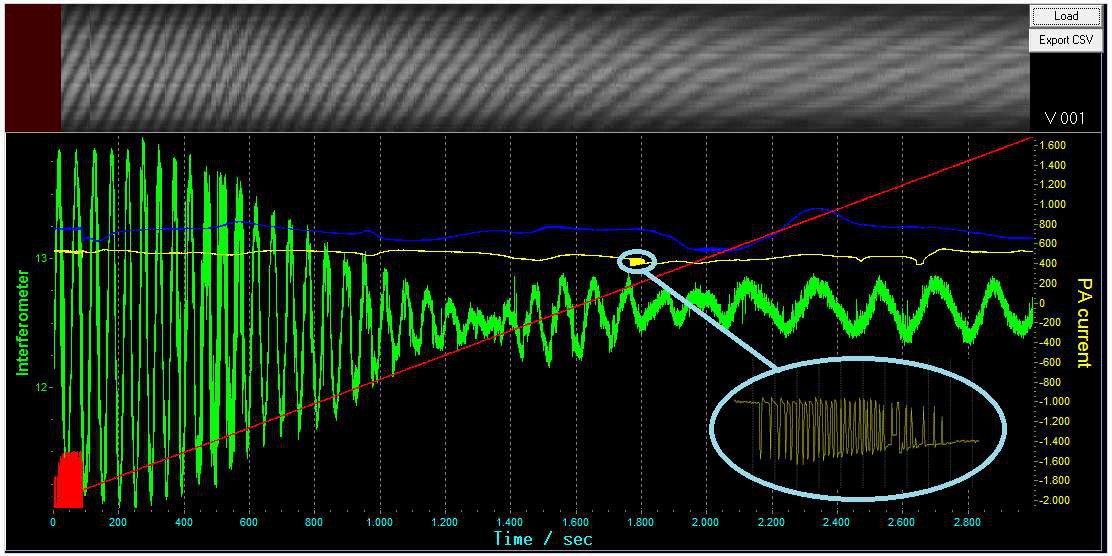Just made a long time recording. I noticed this pattern here which also occurs in some short time recordings (in reduced resolution). I fixed the bug in the gfx, so it´s working now for long time recordings.
As you can see, the interference pattern is drifting over time, so the green curve becomes useless. I think I´ll need to code a tracker for the optical pattern.
But back to the phenomenon showed in the picture: What causes this oscillation? Is it a resonance phenomenon or some intermodulation due to the 5V-step-up converter? The real frequency is rippling relatively slow within a few MHz, maybe it´s the point it hits resonance while rippling around the center frq and so causing these peaks? I don´t know. Anyway it happens always around this frequency and only with the cavity connected, so it´s reproducible.
Do you have an idea?
(Data for the viewer is in the repository under Charts\AUX\20150929-03-...)

 Paul Kocyla
Paul Kocyla
Discussions
Become a Hackaday.io Member
Create an account to leave a comment. Already have an account? Log In.
The raw interferometer pattern changes are interesting. I'm wondering if the distortion has to do with the number of degrees of freedom your 'resonance cavity platform' has to shift in.
As in, it appears it can move along x - the axis of thrust/observation. But. It could also be twisting around a vertical axis. Or shift along the other horizontal axis. Or some slight combination of pitch/yaw even. Any of these other than pure x should be pattern distorting - and you have pattern distortion.
Possible thoughts:
1) Attempt to determine a center of gravity and put the thrust vector through/over it. Close should count - anything to reduce torque.
2) Instead of coiled-wire-springs underneath, could it it be more of a knife-edge for the supports? A couple pieces of flat, springy metal parallel to either face-plane of the cavity won't flex much in any way other than 'x', or perhaps some 'pitch'. Eliminating 'roll', 'yaw' and 'y' should at least clear some of the possibilities off the table. I'm thinking of the sort of whippy/springy thin metal used in flushcutting saws like the Stanley 20-331.
3) Or perhaps back to hanging?
I'm also wondering about: Take -everything- and float it in something like a concrete/mortar-mixing tub. (Large, flat, boat-like). Both for vibration resistance and as a damper on and potential room-temperature swings.
Are you sure? yes | no
Thanx for the great ideas and suggestions. I´ll apply them to improve the testrig when we don´t get good data.
Are you sure? yes | no
about the drifting pattern; try to attach a temperature sensor on the cavity to be sure that temperature is stable and not affect the recording. The microwave generator itself is quite hot (you know that metal expands when heated, and this can cause different test results) the tremble can also be a cause of expanding. (remember, a central heating unit pops sometimes due to thermal expansion. it can also be a resonance in the generator itself. You need to rule all out. (maybe cooling ribs around the cavity, i dont know )
Are you sure? yes | no
True, i made some new tests and they show drifts probably caused by temperature. I changed the approoach now and am controlling the PA current to keep the RF source at same temperature.
Are you sure? yes | no
Neat - do you have data for the PA at a rate higher than 5Hz? You can't really see the whole waveform. Looks like the interferometer is the bigger issue atm.
Are you sure? yes | no
A higher rate would require a new firmware on the RF source. If this leads into the right direction, then I will implement a higher speed sampler.
Or even easier: I could measure the current with an oscilloscope and a current probe (which I would have to build yet).
The interferometer drifts, but quite slowly. Maybe if I focus on one frequency and make ON/OFF sequences there are better chances to see something.
Are you sure? yes | no
you can also try a alternating frequenty sweep between two freqenties
Are you sure? yes | no